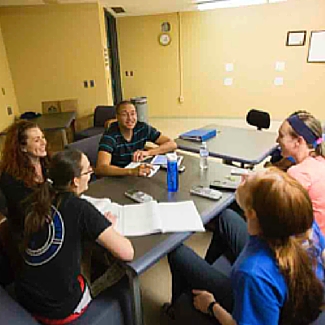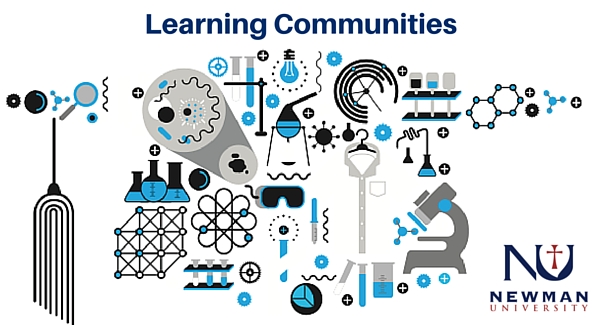Imagine walking into your very first college class. You’ve been thinking about this day for years, and you’re excited, but the unknowns race through your head. How many people will there be? Am I dressed like a college student? Did I buy the right book? The anxiety builds as you open the door and walk into a room full of new faces.
That wasn’t so bad! But as you leave, thinking about the plethora of papers and projects listed on the syllabus and making your way to the next building, the self-doubt starts all over again. What will the professor be like? Am I walking into the correct classroom? Is this even the right building? As you hold your breath, you grip the handle, open the door, and . . . stop in your tracks. Aren’t these the same people from my last class? What are they doing here?
Welcome to your freshman Learning Community!
Students who choose to attend Newman University are asked to select one when enrolling for classes. But what exactly is a “learning community”?
It’s precisely what it sounds like – a community of learners! Each fall, groups of 18 to 24 freshmen experience a couple of their first college classes (plus a freshman seminar) together. This feeling of community fosters strong relationships between fellow students and with faculty members. Along with a student facilitator, who serves as a mentor, freshmen get to engage in relevant and meaningful course work as they encounter exciting connections between diverse subjects. They also learn what it takes to be a successful college student by orienting themselves to Newman University and the various services offered to its students.
“I liked being able to make friends with a group of people right away,” remarks Miranda Hejny, Great Bend, Kan. “The first few days were overwhelming enough, so it was nice knowing I had friends already!”
National data suggest that students who participate in a learning community are more likely to stay enrolled in college and have an overall higher GPA. To Professor of History Dr. Cheryl Golden, the collaborative classes are a huge asset to Newman and its students.
“Learning communities allow new students to form common bonds, outside the comforts of their hometown and athletic team,” Golden says, “and it allows them to gain confidence in learning new material.”
Not only is the faculty raving about these classes, but the students see the value in it as well.
Delaney Hiegert, Topeka, Kan., says, “It gives students, who haven’t quite found their niche yet, an opportunity to meet others that share their same interests.”
This fall, new students were able to choose from five different learning communities, each 
Medicine, Literature, and the Human Condition – In this course, students interested in studying English or going into the medical field strive to become better readers and writers in College Writing I. They listen and respond to representations of illness from an array of perspectives.
The Art of Civilization – Combine art and history classes, as well as take field trips around Wichita with your peers, to better understand how human creativity has affected world history.
Lab Rat Pack – You’ll be spending a lot of time together in the lab over the next four years, so science majors who enroll in this community will experience their general biology and chemistry labs together – providing the opportunity to form study groups and begin scientific dialogue with peers early on.
Reacting to the Past – Hone your communication and writing skills in a variety of historical role-playing experiences in this community.
Problem Solving in a Digital World – New this fall for students interested in information technology and computers.

